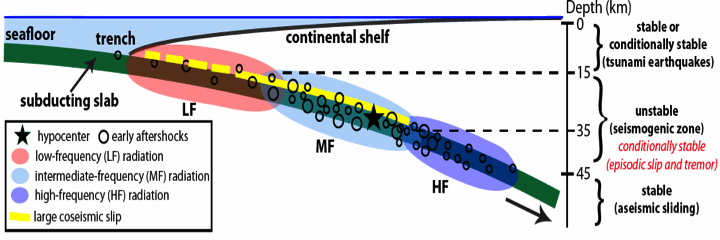Current Research
1. Compressive sensing of earthquake rupture imaging
Results for the Mw 9.0 Tohoku-Oki Earthquake in Japan reveal apparent along-dip frequency-dependent rupture modes of this megathrust earthquake (PDF download).
Results for the 4 largest subduction zone earthquakes since 2000: depth and frequency dependent seismic radiation along the subducting slab interface (PDF download).

Seismic observations of subduction zone megathrust earthquakes and frictional stability regimes of the subducting plate interface.
The yellow dashed line suggests possible large coseismic slip in the shallow portion of the slab interface in the case of tsunami earthquakes.
2. Earthquake rupture imaging using an iterative back projection (IBP) method and subevents signal stripping technique
Results of the Tohoku, Japan earthquake in 2011(PDF download)
3. Use array technique to investigate tremor locations and source properties
4. Use continuous data from Ocean Bottom Seismometers (OBSs) in the Eastern Pacific Rise tranform faults region to understand the structure of young oceanic lithosphere near the ridges
5. Use ambient noise and surface wave array tomography to understand the shallow surface and lithosphere structure in China, including Tibetan Plateau, SW China, North China Craton, etc.
6. Investigate the generation mechanisms of microseisms at the ocean bottom using OBS data